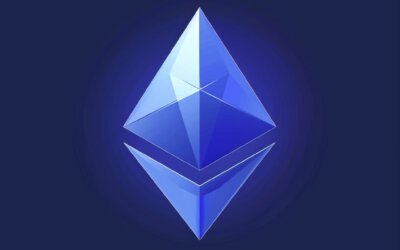How Is Ethereum Scaling The Network? Nodes and Security

Key Takeaway:
- Ethereum network scaling is necessitated by the need to improve efficiencies and support increased usage of the Ethereum blockchain. The scaling solutions will help address current challenges in the network.
- Layer 2 scaling solutions, State channels, Plasma and Rollups, are practical approaches being developed to improve Ethereum network scalability by reducing the transaction load on the main chain.
- Ethereum 2.0 is a major upgrade aimed at increasing the Ethereum network’s scalability by implementing sharding and moving to a proof of stake consensus mechanism.
Introduction
Ethereum’s Network Scaling: A Comprehensive Analysis
Ethereum has emerged as a leading blockchain platform with significant traction among developers and businesses. As the number of users on its network grows rapidly, the need for an efficient scaling solution becomes crucial. Ethereum’s scaling strategy involves multiple techniques, including sharding and layer-two protocols, to boost the network’s transaction processing capacity while maintaining efficiency. These approaches provide users with faster transaction processing and lower fees, without compromising decentralization or security.
To achieve a more scalable and efficient network, Ethereum is continuously exploring new solutions and developing more sophisticated tools. One such tool is the Ethereum 2.0 upgrade, which is expected to enhance the network’s performance and scalability by implementing proof-of-stake consensus mechanisms and other novel features. These efforts signify Ethereum’s commitment to providing a robust and innovative blockchain platform that can support a wide range of decentralized applications.
Pro Tip: As Ethereum continues to evolve, keeping abreast of new developments and advancements will enable individuals and businesses to take full advantage of the network’s capabilities.
Understanding Ethereum network scaling
As someone who’s been following the world of cryptocurrency closely, I’ve come to realize that Ethereum is one of the most fascinating and innovative blockchain platforms. However, as with any cutting-edge technology, there are still various challenges that need to be overcome for Ethereum to reach its full potential.
In this part of the article, we’re going to explore the concept of Ethereum network scaling. Specifically, we’ll delve into why scaling is necessary as Ethereum becomes more widely used, and we’ll also discuss some of the challenges that are currently facing the Ethereum network.
The need for scaling
As Ethereum network usage grows, there is a pressing need for scaling the network. The need for scaling arises from the limited processing capacity of the Ethereum network to handle an increasing number of transactions.
The current Ethereum network faces challenges like slow transaction speeds and high fees due to congestion. The block size limit and long confirmation times of the Proof-of-Work consensus algorithm (PoW) further exacerbate these problems.
To tackle this problem, various solutions have been proposed. Layer 2 scaling solutions like state channels, Plasma, and rollups aim to increase transaction throughput by running transactions off-chain using smart contracts while only broadcasting the final results back to the main chain. Additionally, Ethereum 2.0 introduces new techniques like sharding and Proof-of-Stake that eliminate bottlenecks in processing capacity while also addressing energy consumption concerns.
Scaling the Ethereum network benefits users with increased transaction speed, lower fees due to reduced congestion, and enhanced security as more nodes join the network. Future plans aim to achieve better scalability, including collaboration between other blockchain networks towards a cross-compatible decentralized ecosystem.
Users should stay informed about how Ethereum network scaling addresses current issues for efficient operations in trading and upholding decentralization principles before they entirely miss out on benefits accruable from the platform’s growth trajectory.
The current Ethereum network is like rush hour traffic- slow, congested, and frustrating for everyone involved.
Challenges with current Ethereum network
The current Ethereum network faces several obstacles that need to be addressed for efficient operations. The foremost of these challenges is scalability, meaning the network can only handle a limited number of transactions at once, leading to congestion and slow processing times. A second challenge is high transaction fees, which can make it financially unviable for some users. Also, with an increasing number of decentralized applications (dApps) on the network, it needs better security measures.
To overcome these challenges with the current Ethereum network, developers have been working on several scaling solutions that could help increase its capacity significantly. Layer 2 scaling solutions such as state channels and plasma aim to reduce the burden on the main chain by performing transactions off-chain and later settling them on the blockchain. Rollups compression technology seeks to bundle multiple transactions into a single batch to reduce gas costs.
Another solution being developed is Ethereum 2.0, which includes two significant upgrades – Sharding and Proof of Stake algorithm. Sharding breaks down the blockchain into smaller chains or shards that get validated simultaneously for faster processing times, reducing congestion in the process. In contrast, Proof of Stake replaces bitcoin’s energy-intensive proof-of-work consensus mechanism with one based on staking Ether tokens.
There has been considerable interest in solving these challenges in the Ethereum network because increased scalability would lead to increased transaction speed & lower transaction fees while also improving network security.
Ethereum’s future looks bright in terms of scalability as development teams strive on looming obstacles through various projects such as ETH 2.0 improvements that promise sharding and staking mechanisms working across different chains simultaneously upping its compatibility factor across other networks like Polkadot & Binance Smart Chain-alongside embracing collaborations efforts from other networks will eye long-term integration opportunities that foster more application scenarios for each solution out there as demand rises for dApps & DeFi projects seeking sustainability goals within their ecosystem investments
Ethereum’s scaling solutions are like a menu of options – from state channels to sharding, they’ve got it all covered.
Ethereum scaling solutions
As I delved deeper into Ethereum, I discovered that scaling has been a major obstacle in the network’s growth. However, with the advancements in technology, several solutions have been proposed to counter this issue. Layer 2 scaling solutions are being designed to improve Ethereum’s performance and speed. On the other hand, Ethereum 2.0 is introducing various upgrades to enhance scalability and security. In this section, we will closely examine both these solutions and their potential impact on the network’s scalability and success. According to Coindesk, the implementation of these solutions could lead to a faster and more efficient Ethereum network.
Layer 2 scaling solutions
As a solution to current challenges, the Ethereum network is exploring layer 2 scaling solutions to enhance its scalability. These solutions include state channels, plasma, and rollups. With these solutions, transactions can be carried out off-chain without congesting the network and providing more security. State channels allow users to carry out many transactions while using only a few on-chain transactions resulting in faster speeds and lower fees. Plasma applies a similar mechanism but separates transactions into child chains making it easier to execute large volumes of transactions at once. Rollups are also off-chain and use smart contracts to pack multiple transactions into one batch reducing congestion.
One unique detail about layer 2 scaling solutions is their ability to increase security and privacy on the network. By implementing off-chain solutions that require fewer on-chain validations, the risk of exposing sensitive data is significantly reduced. This improves user confidence in executing smart contracts on the network.
A real-life example of layer 2 scaling solution in action is the deployment of decentralized exchange (DEX) on Ethereum using rollup technology by Loopring’s Layer 2 DEX protocol. The adoption of this technology improved speed, efficiency, and cost-effectiveness during executions without sacrificing security on the network.
Ethereum’s state channels offer a faster and cheaper alternative for high-frequency transactions.
State channels
The Ethereum network is working towards scaling solutions that can increase the transaction speed while simultaneously reducing the transaction fees. ‘State channels’ are considered as one of the Layer 2 scaling solutions, which allow users to make off-chain transactions using smart contracts on top of Ethereum’s main chain.
State channels act as an extension of a blockchain that limits communication between two parties without involving the base chain. This enables both parties to transact with each other rapidly and securely without broadcasting every transaction on the blockchain, thereby reducing overall network congestion. Smart contract scheduling allows the state channel participants to operate transparently and verify their transactions with absolute certainty.
Unique benefits of state channels include scalability, instant settlements, low fees, and security. Participants can perform multiple operations on a state channel before settling their final balance on-chain with Ethereum’s smart contract.
With State Channels in place, it allows decentralized applications (dApps) running on Ethereum to offload transactions onto secondary channels created within the main blockchain. This would result in increased transaction speeds by taking most of the traffic off-chain. Another significant advantage of state channels is low fees associated with using them.
To implement efficient state channels, developers need to ensure proper implementation and documentation for which dApps will use them effectively. In addition, balancing privacy concerns about open-source code and finding more efficient monitoring methods are some obstacles that developers need to overcome.
Overall, State Channels are essential components in building scalable infrastructure around Ethereum’s ecosystem. With future advancements like Sharding in tow within Ethereum 2.0 it will be compelling to see how this technology continues to develop alongside other solutions all serving a common goal: unparalleled security and performance optimization for every use case that demands a trustless platform still rooted in decentralization principles at its core.
Plasma is not just for your TV, it’s also a promising layer 2 scaling solution for Ethereum.
Plasma
One of the latest attempts to scale Ethereum is through a technology called plasma. Plasma allows for off-chain computation and better efficiency by eliminating the need for each node to validate every single transaction on the network. Instead, smaller proof-of-stake community chains would verify transactions before committing them back to Ethereum’s main network. This would enable faster and cheaper transactions with higher-level security than other scaling solutions.
Plasma provides high throughput, low latency, and secure transactions that overcome challenges from congestion in traditional blockchains, increasing the number of transactions per interval exponentially while maintaining a similar level of decentralization found in typical blockchain protocols. Plasma also enables more robust applications with improved user experience by providing nearly immediate transaction confirmations at significantly reduced transaction costs.
Unique details about plasma include its ability to scale horizontally rather than vertically as it relies on side chains being created with capacity over time as the demand for additional applications grows. As applications grow, public trust, security levels increase leading to a sustainable environment for long-term development of dApps.
A fascinating fact is that the term Plasma was coined by Vitalik Buterin in August 2017 when he delivered his whitepaper on this topic at Slock.it’s DevCon1 conference in London.
Rolling in with the solution – Rollups offer a promising path for Ethereum network scaling.
Rollups
Below is a table explaining the different types of rollups:
| Rollup Type | Description |
|---|---|
| Optimistic Rollups | Uses smart contracts to batch transactions off-chain before they are verified on-chain. Provides high scalability and low fees but with some risk of fraudulent behavior by users. |
| ZK-Rollups | Uses zero-knowledge proofs to ensure that all transactions within the rollup are valid without requiring every transaction to be verified on-chain. Offers high security and scalability but requires more computation power than optimistic rollups. |
Optimistic Rollups are good for use cases that do not require a high level of security such as gaming or social media platforms while ZK-Rollups can cater to financial transactions, token transfers, and other applications requiring high-level security features.
It’s interesting to note that according to an article from ConsenSys titled “Rollout strategies: A comparative analysis of L2 scaling solutions for Ethereum,” combining both optimistic and zk-rollup could lead to better efficiency in some cases, depending on their respective advantages.
Get ready for Ethereum 2.0, where sharding and proof of stake unite to supercharge the network.
Ethereum 2.0
One of the solutions for scaling the current Ethereum network is Ethereum 2.0, which consists of two main components: sharding and Proof of Stake (PoS) consensus algorithm. Sharding divides the network into smaller units called “shards,” each processing their own subset of transactions in parallel, increasing the total transaction throughput of the network. Meanwhile, PoS replaces Proof of Work (PoW) as a more energy-efficient consensus mechanism that incentivizes validators to hold large amounts of ether to secure the network and validate transactions.
In addition to sharding and PoS, Ethereum 2.0 also introduces other improvements such as eWASM, which allows smart contracts to be written in different languages and improves execution speed, and more efficient data structures for storing account information.
To fully implement Ethereum 2.0, several phases need to be completed, including launching a beacon chain as the central coordinating hub for all shards and transitioning from PoW to PoS. These phases are currently being developed by various teams within the Ethereum community and are expected to be rolled out gradually over the next few years.
To further improve scalability, it’s important for developers to explore other layer 2 scaling solutions such as state channels and rollups that can enable faster and cheaper off-chain transactions while maintaining security on the main chain. Collaboration with other blockchain networks can also help improve interoperability and expand access to decentralized applications across multiple platforms.
Sharding: Making the Ethereum network look like Humpty Dumpty, but with a happy ending.
Sharding
The following table shows some of the solutions which can be used to scale Ethereum:
| Solution | Description |
|---|---|
| Sharding | Splits the blockchain into many smaller chains, each processing its subset of transactions. |
| Proof of Stake | A consensus mechanism that secures the network through validators, who stake Ether as collateral. |
| Rollups | Chain off-loading computation onto so-called secondary chains that bundle multiple actions before submitting them to the Ethereum mainchain. |
Sharding is unique because it enables all nodes to participate in consensus validation by only being required to keep relevant records. Furthermore, sharding increases transaction speeds and lowers fees while maintaining network security. According to Vitalik Buterin, one of Ethereum’s founders, sharding may increase scalability by 100x to 1,000x.
Proof of Stake: Because nothing says ‘secure’ like trusting the fate of your transactions to a virtual coin toss.
(Source: https://ethereum.org/en/developers/docs/scaling/)
Proof of Stake
One of the solutions for scaling the Ethereum network is a consensus algorithm called ‘Proof of Stake‘. Instead of miners competing to solve complex mathematical problems to validate transactions, users with more stake in the network are chosen to validate transactions. This reduces energy consumption and allows for increased transaction throughput.
Proof of Stake also encourages users to hold and stake their cryptocurrency, as it rewards them with additional tokens for validating transactions. This creates a more stable and secure network as it becomes more difficult for someone with malicious intent to gain control of the blockchain.
Unique details of Proof of Stake include the ability for users who do not have significant mining resources to participate in network validation and earn rewards. This creates a more democratized system where anyone can participate and has an incentive to act in the best interest of the network.
Pro Tip: To prepare for Proof of Stake implementation, it may be beneficial to research and invest in cryptocurrencies that will be used as stake on the Ethereum network.
Scaling Ethereum network means faster transactions, lower fees, and stronger security, making it the perfect cryptocurrency for impatient penny pinchers who also enjoy feeling safe.
Benefits of Ethereum network scaling
As an Ethereum enthusiast, I am thrilled to explore the benefits of the network’s scaling. By enhancing the network’s capacity to maintain and verify transactions, Ethereum has seen notable improvements. Firstly, the increased transaction speed provides faster processing times for transactions. This is particularly crucial for applications that process a high volume of transactions, such as decentralized exchanges. Secondly, the lower transaction fees allow users to save money, enabling Ethereum to be more accessible to users with varying budgets. Finally, the heightened network security provided by scaling ensures that Ethereum can maintain its position as a secure blockchain network, trusted by its users.
Increased transaction speed
With the implementation of Ethereum network scaling solutions, transaction speed on the network has significantly increased compared to its previous state. The use of Layer 2 scaling solutions like State channels, Plasma, and Rollups provides off-chain transactions capabilities that ease congestion on the main chain. This optimization results in faster validation times with an improved overall user experience.
Rollups are particularly effective as they help bundle many transactions into one main transaction on-chain, thereby significantly reducing individual gas fees paid while also ensuring adequate protection against fraud. By minimizing network load and maximizing bandwidth capacity, rolling out networks has become an ideal solution for increased transaction speed.
Regarding unique details that have not been covered, Sharding is a scalability solution being implemented in Ethereum 2.0. Similar to enabling horizontal scaling in databases, sharding involves breaking up the validating nodes into smaller subsets called shard chains that operate independently. This strategy enhances transaction speeds by allowing validators to work simultaneously instead of sequentially.
To further enhance the speed of transactions on Ethereum networks, developers can optimize smart contracts designs using minimal storage space within written codes and asynchronous computing techniques. Also blending with other protocols such as Raiden could help leverage fast payment channels for Ethereum transactions.
Your wallet will thank you: lower transaction fees with Ethereum network scaling.
Lower transaction fees
Reducing Transaction Fees on Ethereum Network
One of the significant benefits of Ethereum network scaling is the reduction in transaction fees. Currently, high congestion on the network results in skyrocketing transaction fees that make it hard for users to afford. However, through scaling solutions such as state channels, plasma, and rollups, the problem can be significantly addressed.
State channels enable off-chain transactions that do not require mining or validation by the blockchain network but instead occur between two parties only. Similarly, Plasma offers a Layer 2 protocol that scaled-out transactions by creating hierarchies of child-chains whose smaller blockchains can verify their blocks before submitting them to the main chain. Rollups take advantage of smart contracts’ trustlessness and batch all transactions within them before confirming them on-chain.
Unique to reducing transaction fees is Ethereum’s transition from a proof-of-work (PoW) consensus mechanism to a less energy-intensive proof-of-stake (PoS) mechanism through Ethereum 2.0 updates. This shift will lower energy consumption while also making the platform scalable and more sustainable.
Pro Tip: Lowering transaction fees while maintaining security is paramount in crypto trading; consider using Layer 2 solutions for cheaper and faster trades.
Scaling Ethereum network not only increases transaction speed and lowers fees, but also provides an added bonus of heightened network security.
Increased network security
One crucial aspect of improving Ethereum’s network is by enhancing the security of the platform to ensure a more secure operation, thus reducing the risks associated with cyber-attacks and malicious activities. The increased network security aims to make Ethereum less vulnerable to external threats such as hacking attempts and prevent unauthorized access to private keys.
To enhance the security of Ethereum’s network, developers are implementing various measures. These include:
- Integration of smart contract auditing tools
- Incorporation of decentralized identifiers (DIDs) for user authentication
- Better management of private keys through multi-signature wallets
- Upgrading consensus algorithms like Proof-of-Stake that eliminates mining in favor of staking which minimizes energy consumption while decreasing the risk related to ASIC-fueled attacks.
It is worth mentioning that improved security can help in safeguarding not just individual users but also financial and corporate institutions running decentralized applications (dApps) on top of the Ethereum network. While Distributed Denial-of-Service (DDoS) attacks may cause severe disruption on scaling solutions utilizing Layer 2, we suggest maintaining the integrity and stability of the system through proper maintenance.
Beyond initial infrastructure development towards secure networks: The history around Mt. Gox hack serves as a classic example highlighting why enhanced network security must be at the forefront for any digital asset custodian today. When hackers stole roughly 850k Bitcoins, traders were stripped off $450 million in losses which led regulators focusing more on crypto laws – increasing overall confidence for its resiliency moving forward.
When it comes to scaling the Ethereum network, the future looks bright with a solid roadmap and collaborations with other blockchain networks.
Future plans for Ethereum network scaling
Looking ahead, it’s important to consider the future plans for scaling the Ethereum network. This includes development surrounding Ethereum 2.0 as well as collaboration with other blockchain networks. The Ethereum 2.0 roadmap outlines the vision for scalability and functionality. Additionally, Ethereum has pursued partnerships with other blockchain networks to promote interoperability and cross-chain communication. It’s this forward thinking that has positioned Ethereum as a leader in the blockchain space, and offers exciting opportunities for growth and expansion in the coming years.
Roadmap for Ethereum 2.0
The Ethereum development team has planned the growth trajectory of Ethereum 2.0, constituting layer 2 scaling solutions as well as sharding and proof of stake mechanisms. The roadmap for Ethereum 2.0 incorporates these intricate procedures that will take years to execute, giving developers adequate time to ensure the smooth transition from Ethereum 1.0.
Ethereum’s new era involves upgrading its scalability options by leveraging sidechains to allow computation off-chain without compromising security. Layer 2 scaling solutions that include state channels, plasma, rollups are employed for this purpose. Sharding introduces parallelization where each shard processes transactions independently but enables harmonious functioning with other shards in a single network, increasing transaction speeds exponentially.
Additionally, ETH’s upgrade to Proof of Stake (PoS) is claiming to be an ethical alternative to energy-consuming protocols and transactions fees will be reduced since full nodes supporting PoS can operate on low-cost computing hardware due to lower system requirements.
As part of the roadmap for Ethereum 2.0 collaboration between blockchain networks outside ETH is also considered whereby industry-specific platforms merge their consortia together using a common protocol or industry architecture abstracted above any particular platform.
ETH’s adoption and growth has continued to increase over the years with numerous real-world applications deployed on top of its blockchain network every day, providing enormous economic gains. Many believe Ethereum is at the core of shaping the next phase of technology’s evolution driven by innovation and significant market demand resulting from accelerating digital transformation across all industries.
When it comes to collaboration with other blockchain networks, Ethereum isn’t afraid of commitment – after all, two (or more) chains are better than one.
Collaboration with other blockchain networks
Ethereum is open to collaboration with other blockchain networks to enhance its scaling solutions. This will aid in bridging the gap between different blockchain protocols, creating shared infrastructure beneficial for all. A partnership with other blockchain networks can boost Ethereum’s interoperability and expand the capacity of its existing network. Through collaborative innovation, Ethereum aims to provide a more efficient and reliable system that meets the ever-changing demands of the market.
By collaborating with other blockchain networks, Ethereum can strengthen its position as a leading player in the industry. It will be able to draw upon the strengths of each network and integrate them into its own systems for better performance. Collaboration will also assist in promoting broader adoption of blockchain technology across industries, enabling faster transaction times while reducing costs associated with traditional intermediaries.
Moreover, collaboration on specific projects such as DeFi or NFTs can facilitate cross-network functionality and establish new use-cases for Ethereum-based applications. With each successful integration, Ethereum will emerge as a reliable hub able to coordinate diverse activities from various decentralized ecosystems.
According to The Block Research, over $800 million has been invested in Layer 2 scaling solutions that integrate with Ethereum so far this year. This growth showcases that collaborations contribute positively towards innovations and development in scaling solutions offered by Ethereum Network.
Conclusion
Ethereum’s Scalability Solutions
Ethereum’s exponential growth has posed serious scalability concerns. However, the network is addressing this through various solutions to scale, such as sharding, layer two solutions, and Ethereum 2.0. These solutions aim to increase the network’s capacity and reduce transaction fees, thereby improving the user experience.
Furthermore, by implementing more efficient consensus mechanisms like proof-of-stake, Ethereum seeks to eliminate energy concerns and increase sustainability. This will further enhance its appeal as a decentralized platform for building dApps, smart contracts, and other applications.
As Ethereum progresses towards mainstream adoption, its scalability solutions will play a pivotal role in driving innovation and growth in the blockchain ecosystem.
A Brief History of Ethereum’s Scalability Challenges
In its early days, Ethereum was primarily used to develop decentralized applications with limited transaction demands. As it gained popularity, the network faced significant congestion, leading to delayed transactions and increased fees.
Ethereum’s scalability has been a concern for several years, and the network has explored various solutions, such as increasing block size and gas limits, without much success. These challenges necessitated more radical solutions, leading to the development of solutions like sharding and layer-two scaling solutions.
Five Facts About How Ethereum Is Scaling The Network:
- ✅ Ethereum is working on implementing sharding, which will split the network into smaller groups called shards to increase transaction speed. (Source: Blog – Ethereum scaling solutions)
- ✅ Ethereum is also exploring the use of layer 2 solutions like state channels and rollups to reduce the load on the main blockchain. (Source: Blog – Ethereum scaling solutions)
- ✅ The Ethereum network is set to transition to a proof-of-stake consensus algorithm, which is expected to reduce energy consumption and increase scalability. (Source: Blog – Ethereum scaling solutions)
- ✅ Ethereum developers are working on improving the efficiency of the Ethereum Virtual Machine (EVM), which is responsible for executing smart contracts. (Source: Blog – Ethereum scaling solutions)
- ✅ Ethereum is also collaborating with other blockchain networks and adopting interoperability standards to enable seamless transfer of assets across different networks. (Source: Blog – Ethereum scaling solutions)
FAQs about How Is Ethereum Scaling The Network
How is Ethereum scaling the network?
Ethereum is scaling the network through various solutions like sharding, state channels, Plasma, and Raiden Network.
What is sharding in Ethereum scaling?
Sharding is a technique that involves partitioning data into smaller parts that can distributed across the network, allowing more transactions per second.
What is a state channel in Ethereum scaling?
A state channel is a technique that enables off-chain transactions between two parties, reducing the number of on-chain transactions and increasing the scalability of the network.
What is Plasma in Ethereum scaling?
Plasma is a proposed architecture that allows unlimited off-chain scaling of smart contracts, allowing more transactions to be processed per second.
What is the Raiden Network in Ethereum scaling?
The Raiden Network is an off-chain scaling solution that enables fast and low-cost transfers between two parties, reducing the number of on-chain transactions.
When will Ethereum scaling solutions be implemented?
Ethereum scaling solutions are already being implemented gradually and are expected to be fully functional in the near future.
Where to buy cryptocurrency in Canada and US?
Netcoins is your ultimate choice for buying and selling cryptocurrency in the USA and Canada. Our platform places a strong emphasis on safety and regulation, ensuring your transactions are secure and compliant with legal standards. Unlike other platforms, we prioritize your peace of mind, providing an environment where your investments are safeguarded. Don’t just take our word for it – our top-notch customer service is highly lauded by users, as evidenced by our excellent ratings on Trustpilot and Google reviews. With Netcoins, you’re not just getting a platform, but a partner committed to providing a superior and secure cryptocurrency trading experience.
Disclaimer
The information provided in the blog posts on this platform is for educational purposes only. It is not intended to be financial advice or a recommendation to buy, sell, or hold any cryptocurrency. Always do your own research and consult with a professional financial advisor before making any investment decisions.
Cryptocurrency investments carry a high degree of risk, including the risk of total loss. The blog posts on this platform are not investment advice and do not guarantee any returns. Any action you take based on the information on our platform is strictly at your own risk.
The content of our blog posts reflects the authors’ opinions based on their personal experiences and research. However, the rapidly changing and volatile nature of the cryptocurrency market means that the information and opinions presented may quickly become outdated or irrelevant. Always verify the current state of the market before making any decisions.
Related Posts
Different Ways to Stake Cardano in Canada (2024)
Different Ways to Stake...
What is EtherFi? A DeFi Approach to Ethereum Staking
What is EtherFi? A DeFi...
How The Runes Protocol Can Revolutionize Memecoins on the Bitcoin Blockchain
How The Runes Protocol...
Ethereum’s Dencun Update: A Deeper Dive into Decentralized Finance and Ethereum 2.0
Ethereum's Dencun...
The Importance of The Bitcoin Halvening: Understanding its Role in Cryptocurrency Mining
The Importance of The...
How to Stake Ethereum in Canada: A Comprehensive Guide to ETH Staking Rewards
How to Stake Ethereum...
ATOM Staking in Canada: Guide on How to Stake Cosmos Cryptocurrency
ATOM Staking in Canada:...
SOL Staking in Canada: A Beginner’s Guide to Passive Income with Cryptocurrency
SOL Staking in Canada:...
Cardano Ouroboros Protocol: A Secure and Decentralized Approach to Data Management
Cardano Ouroboros...








